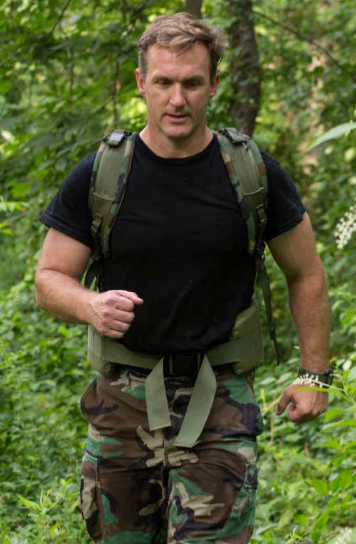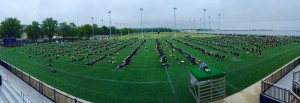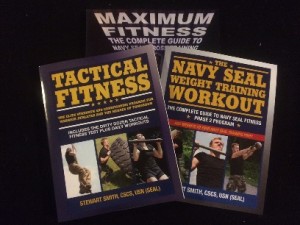
Fighting Shape: Military Fitness Secrets from Navy SEAL Stew Smith
Former Navy SEAL Stew Smith wrote the book on military fitness. Actually, he wrote 40 books on the subject. Here’s what you can learn from the master to get into the best shape of your life.
BY MATT TUTHILL
RI MAGAZINE: Military fitness gets a lot of attention from younger people, especially young guys, because it has a hardcore connotation to it. But for older folks or for people who have been away from the gym for a while, what can they learn from your fitness philosophy?
STEW SMITH: I first started writing about fitness when I got out of the military 20 years ago. Back then I geared everything towards the people who were looking to get into special operations programs. So it was focused on a very high level of fitness, specifically how to pass the fitness tests required in that world.
People like the fitness test idea. The popularity of military fitness started to seep into everyday training. [ED Note: As an example, CrossFit’s benchmark WODs serve as tests within that community.] People can gauge their progress with a military fitness test and see if they’re up to standard. If you’re 35 years old and you can still pass the standard to be in the Army as an 18-year-old, that’s very satisfying.
What many people don’t realize is that military fitness doesn’t require a whole lot of equipment. A lot of people get intimidated by the military-style workout, but really it’s calisthenics and running. You would add swimming if it’s a program that’s going to have you in the water like diver or Navy SEAL, things like that.
After you pass the test to get in, the next phase of military fitness is to get through the training. That requires a little more specifics to what you’re trying to do. It’s not just a general workout per se. It would have to be more specific to your goal and the training that’s in your future. Let’s say if you’re going into the Navy SEAL training, you’re going to have to run, swim, do a lot of calisthenics, lift some weights because you’re going to have boats on your head and logs on your shoulders. Those things require a certain foundation of strength. That’s on the advanced level.
Even though I don’t tend to write for the unfit, I’ve had people lose 80 to 100 pounds and go on to serve in the Army and the Army Rangers. They’ve done some phenomenal things.
I tend to focus on the high end level, however, I do have lower end level that is geared towards pure weight loss and getting in shape at the same time, using some of the same methods that the military will require of them. I have a 90-Day Beginner Fitness book. People tend to lose 40 to 50 pounds in 90 days using that program. If they have it to lose, they tend to lose it.
RI: Your workouts are based in a lot of athletic, multi-joint movements. What do you think of the old-school bodybuilding approach to things?
SS: Well, there’s nothing wrong with that. I think as we age that’s a really good approach. I just think you still need to do some movements that require multiple joints because that helps you in real life, but there’s nothing wrong with isolation to help you build up joint strength and muscle strength around it, while doing lower-impact cardio.
RI: You have a periodization program that’s very popular. How does it work?
SS: It enables everybody, no matter what level of fitness there is, to go through the year, and, instead of worrying about one workout of a day and repeating that one five days a week or whatever, it changes up the focus every quarter. For instance, in the spring, we are starting to run again; we do a little bit of a transition from a winter weight training program into calisthenics mixed with weights. We do some non-impact swimming or biking or something like that to balance out the cardio.
Then, in the summer it’s a little more running. This is our running cycle and calisthenics cycle typically. Then, in the fall we start with decreasing the running and decreasing the repetitions of the calisthenic and adding more weight training into it. Then, in the winter, it’s just weight training and non-impact cardio, with very little running. What this enables you to do is it enables you to get all the elements of fitness that a lot of people tend to neglect. It’s endurance, muscle stamina, strength, power, speed, and agility. All of those things are thrown into a year’s worth of training, broken up into four focus segments where you never really lose you strength but you’re not at your 100% strength year-round. And best of all it’s not boring.
RI: What is the biggest mistake that you see beginners make?
SS: The biggest mistake is they do too much too soon. They work out too hard. Let’s say they used to be an athlete in college but they let themselves go and didn’t do much for 25 years and now they’re in their mid 40s, 50 pounds overweight and they go back to the gym trying to do the stuff that they last did. Former athletes tend to mess themselves up worse than the beginners because the beginners are very cautious about it; the former athletes go into it a little too hard. In addition to training too hard, they make a ton of dietary changes simultaneously. They start drinking more water, eating clean, maybe they quit smoking—all in the same week. That’s the perfect storm for failure. If you try remove every vice in one week and replace it with a healthy habit you’ll go nuts.
What I tell people is, “Let’s start off with just moving more and drinking more water.” I’m not asking them to quit eating anything. I’m not asking them to lay off any other bad habits.
Usually after a month they start seeing the results and then they start to evolve in month two where they actually have a natural inclination to eat healthier. Then they crave more exercise, too.
Most people get out of shape because they keep eating like they’re 20 years old. No one gets to be 100 pounds overweight overnight. It’s a steady gain of five pounds a year.
You can reverse that, but you need to ease into it. After three months, if you can make it that far, you’ve built a good 90-day habit and that tends to stick. It’s part of your life now. Then, you can start tackling any other vices you may have, if it’s extra calories at night or drinks while watching TV. All of that adds up too of course.
New Year’s resolutions, should be tackled on a monthly basis. You can give yourself one thing to do every month or try it all at once and quit by February.
RI: Part of what you have to battle as a trainer is also a number of myths perpetuated in the fitness industry. For a former Navy SEAL who advocates no shortcuts or tricks, just sustained hard work, what do you think is the most damaging fitness industry myth?
SS: I’ve never been a big fan of supplements. I’m not knocking the whole supplement industry. I take multivitamins and I will even take protein powder, but I think there are way too many supplements out there that make wild claims.
I would much rather focus on good food what I’m actually eating versus having to try to replace it with a pill or a powder. I don’t endorse any supplements. If you look on the back of some of these supplement containers, there’s a little nutrition facts label on the back. If it says nutrition facts, it’s food. If it says supplement facts, it’s not food. And if it says nutrition facts, it has to be regulated by the FDA in order to get that label. I only take protein that says nutrition facts because that ensures me there’s nothing else in it. Sometimes they have proprietary blends, which I have no idea what that means.
RI: You have a book coming out called Tactical Mobility. Mobility is something that everyone should be dedicating some time every day to, right? Especially as more and more people are spending their time at desks and on couches. But a lot of gym rats don’t even do it.
SS: Absolutely. I think every time you stand up there should be some mobility exercise you should do, even if it’s just for 30 seconds to stretch. I’m a writer, so I’ll work out in the morning for a couple of hours and then I’ll go to my desk and I sit all day. I have a standing desk now, which is very helpful, but I can’t stand all day either, so I mix it up a little bit.
I even take a mobility day every week. I train Monday, Tuesday, Wednesday, and by the fourth day I might be a little beat up. That’s my mobility day where I do non-impact cardio for five minutes, stretch for five minutes, and repeat that five times. It’s an hour-long work out, but I am not doing anything other than just getting my heart rate up and temperature up and stretching and rolling out any pain that I have been.
RI: When did you join the military and how long did you serve?
SS: I graduated the Naval Academy in ’91 and then I went straight to SEAL training after that. I finished SEAL training in ’92 and I got out of the military in ’99.
RI: Were you deployed a lot throughout the 90’s?
SS: Yeah, were deployed quite a bit. If it wasn’t for actual deployment like in the Mediterranean area, we were deployed doing a lot of training around the world and the United States as well.
RI: Why did you join?
SS: I always wanted to serve. I knew when I was a kid I wanted to be in the military. My grandads were in the military, it was just was something that I thought was pretty cool. I always had G.I. Joe when I was a kid. It was just one of those things.
Then, I was a pretty good athlete in high school and I actually got recruited by West Point and the Naval Academy and then I was like, “Whoa, I didn’t even think about that. I could go play college sports and go join the military.” It was all working out perfect for me. It was like everything was just falling in line.
Originally, I wanted to be a pilot and then I flirted around with the Marines and then I meet the Navy Seals that were stationed there and I was like, “You know what? This is really cool, I got to try this out.” It was a big challenge because I was horrible when I first started. I actually failed the fitness test when I first got there. I thought I was in shape but I was a power-lifting football player. Anything over 100 yards felt like a long distance to me. I had to evolve into a more hybrid, endurance guy. It took me about a year and a half to do, but once I did it I was on a good path to be a good student going to SEAL training and was able to get there and make it through.
RI: What are you most proud of in your military career?
SS: I would say this: I would rather go through six months of SEAL training, as hard as that is, than to go through four years of the Naval Academy again. I was a good student, but it was brutal, just four years of constant stress. Getting through the Naval Academy was by far the biggest accomplishment I ever had.
I remember being there and being very intimidated by all the valedictorians that were around me. I had a roommate that was a valedictorian that failed out and I’m like, “Oh my God, are you kidding me?”
RI: Can you talk about any of your deployments?
SS: Well, it was a different world before 9/11. It was a completely different world. We would go and deploy to the Mediterranean, and then things would pop up, the United States was involved in Bosnia, so there were times when things were busier than others, then when they weren’t busy. We were working with other countries, we were working with the Spanish and the French and the Italians just creating bilateral training with them, so it was just more of a training deployment than anything.
We were staying in nice hotels, working on the coast of the Mediterranean and now deployments are more to godforsaken places where terrorists live. It’s a completely different world. I got out in ’99, and when I was in you could spend 20 years in special operations and never see combat, it was rare.
Now after 9/11, you could spend been 20 years and you will likely never see peace. It’s a completely different animal today.
RI: Did you see combat?
SS: I did not.
RI: That’s a great blessing.
SS: I did not have to. We were there many times and almost did, but it just wasn’t part of the mission planning back then. Back when I was in, it was more eyes on a target and getting human intelligence.
RI: There are a lot of movies and shows about SEALs. Are any of them accurate?
SS: To a degree. There are some things that SEALs watch and they just cringe because that would never happen, but at the same time I think they do get across the brotherhood of the SEAL mentality, their dedication and commitment not only to each other but to really going to a place and helping out a country that can’t help themselves. It’s a unique breed. People make fun of this millennial generation, and I don’t know why because I don’t see it. I train a lot of kids that want to go serve and want to go do this and they are millennials. They’re just as brave as any greatest generation that’s out there.
I tell people all the time I see a sliver of the greatest generation every morning at six a.m. when I’m working out with these kids because they’re doing it and they’re volunteering to do it. They’re an amazing group. That’s the type of people that I’d like to see when I watch the movies. If they can get across those type of things, that makes for good SEAL movie for me. You can talk about, “Boo-hoo, they didn’t get the tactics right,” but they get the brotherhood.
Follow Stew Smith on TWITTER and shop for his books at STEWSMITH.COM.




